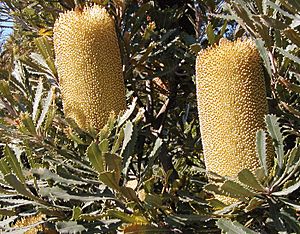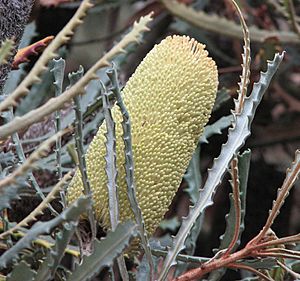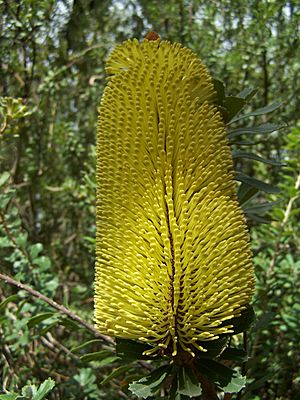Banksia ser. Cyrtostylis facts for kids
Quick facts for kids Banksia ser. Cyrtostylis |
|
|---|---|
 |
|
| B. media (southern plains banksia), the type species of B. ser. Cyrtostylis | |
| Scientific classification | |
| Kingdom: | |
| (unranked): | |
| (unranked): | |
| Order: | |
| Family: | |
| Genus: | |
| Series: |
Banksia ser. Cyrtostylis
(Benth.) A.S.George
|
| Species | |
|
See text |
|
Banksia ser. Cyrtostylis is a special group of plants within the larger Banksia family. Scientists use a system called taxonomy to organize and name living things. This helps them understand how different plants are related. This particular group, Banksia ser. Cyrtostylis, has been classified in different ways over time by various botanists.
Contents
What are Banksia Plants?

Banksia are amazing plants mostly found in Australia. They are known for their unique, often cone-shaped flower spikes and woody fruits. These plants are very important to the Australian environment. They provide food for many animals, like birds and insects.
Scientists group Banksia plants into different categories. These categories help them study the plants better. A "series" is one of these grouping levels, like a smaller family within a larger genus.
How Scientists Classify Banksia Plants
Classifying plants is like sorting your toys into different boxes. Scientists look at features like leaves, flowers, and seeds. They try to find out which plants are most similar.
The group Banksia ser. Cyrtostylis was first described by a botanist named George Bentham in 1870. He called it a "section," which is a higher rank than a "series." He grouped plants that had flat or wavy leaves and a certain style of flower. However, this group included many different types of Banksia plants.
Later, in 1981, another botanist, Alex George, changed the classification. He decided that Cyrtostylis should be a "series" instead of a "section." He defined this group by looking at their slender flowers, small pollen parts, and beaked seed pods. The Banksia media is a good example of a plant in this group.
Changes Over Time
Classifying plants is not always easy. Scientists sometimes disagree or find new information. In 1996, two scientists, Kevin Thiele and Pauline Ladiges, used a new method called cladistics. This method looks at how plants evolved from common ancestors. They found that George's Cyrtostylis group was not as closely related as once thought.
Thiele and Ladiges suggested a new way to group these plants. They moved some species to other groups. They kept only four species in Banksia ser. Cyrtostylis:

However, in 1999, Alex George published another classification. He mostly went back to his earlier ideas from 1981. He kept the Cyrtostylis series similar to how he first defined it. He added a new species, B. epica, to the group.
New Discoveries
Scientists continue to study Banksia plants. Since 1998, Austin Mast has been using DNA sequence data to understand plant relationships. His research often supports the ideas of Thiele and Ladiges. This means that the way plants are grouped might change again in the future.
Understanding these classifications helps us learn more about the amazing diversity of Banksia plants. It also shows how science is always growing and changing as new information is found.
Images for kids
-
B. epica has vibrant yellow flowers.
See also
 In Spanish: Banksia ser. Cyrtostylis para niños
In Spanish: Banksia ser. Cyrtostylis para niños


